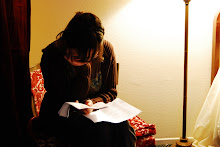
Frederick Jameson has written that one symptom of the post-modern is the nostalgia film; people have lost the ability to connect with the past and present and look to film to make those connections for them. A stream of the recently deceased pass through a way station and must look back on their lives and choose one memory to take with them into eternity. When watching Kore-Eda’s film After life, a post-modern reading is not far away. However, reading the film simply in terms of post-modernism does it a disservice. Kore-Eda has layered After life in meta-filmic moments that on one level suggest a post-modern meaning but on another show that film may still have the power to be meaningful.
The film introduces a variety of characters who reminisce over their lives, searching for their one perfect memory. Once the memory is found it is recreated on film. The person then watches the film of their memory and immediately moves on. In this moment, film is made absolutely necessary for people to reach peace and rest. On one level, this necessity can be read as people’s failure to connect with their pasts on their own, they need mediation. It is not truly their memories they are reliving but a simulacrum of life. One of these people, Watanabe, is an old man who cannot choose. He is looking for an evidence of life but is unable to remember anything. He on his own is unable to connect with his past and only through the use of videotapes can he remember it. These meta-filmic moments, the recreation of memories on film and the videos of a person’s life, reveal films use as a connective tool and leave room for a cynical reading of After life: we are trapped in a post-modern moment and the only escape is through false memories and into an eternity of simulacra, there is no hope.
Of course, Kore-Eda refuses to make his film so simple. In fact, he does offer hope. For example, with Watanabe, while it’s true he needs the videos to remember the past, these representations of memories do not actually help him choose. It is through two conversations, one with Iseya who refuses to choose and one with his counselor who was actually his wife’s fiancé before being killed in WWII, that Watanabe is finally able to choose. He is offered the easy solution of a false connection by randomly choosing a memory off of the tapes, but it is through real connections with other people that his choice is actually made. Another moment of Kore-Eda’s denial of post-modernism is through the girl Yoshino. Originally, she wants to choose a memory of Disneyland (the ultimate example of simulacra) but after a conversation with Shiori, one of the counselors, Yoshino changes her choice to a vague memory of her mother’s lap from when she was a little girl. She turns her back on simulacra and chooses something real.
It can still be said that even with the choice of real memory, by recreating it on film a new simulacra is still being made. And the question of why these films are necessary is never really satisfactorily answered within the narrative but by reading them as a comment by Kore-Eda on the nature of filmmaking itself, it is still possible to move past the post-modern reading. The memory films are not giving a false sense of reality, they are actually making moments of perfection from people’s lives livable again, if only briefly. One noticeable aspect of these memory films is their low budgets (a parallel with the reality of independent filmmaking). These low budgets lead to a necessity of creativity and simplicity. As a result, these films do not focus on creating a false sense of reality through fancy tricks but instead focus on creating a glimpse of the truth of reality through a lack of style. It seems that Kore-Eda is disavowing post-modernism and it’s claim that the possibility of negation no longer exists. Instead, there is a claim that film still has the ability to function as art and that the power of negation is still present.
Kore-Eda wants us to feel that what we are watching is real; he wants us to connect with the film in a meaningful way. He uses the meta-filmic moments to allow us to recognize that we are watching a film and to from there make real connections to it. We are not allowed to mindlessly absorb what we are being presented with, the film engages us and is able to succeed in offering an alternative to the belief in post-modernism. As the counselors watch the moon, one comments that it’s shape never changes only the light reflecting off it makes it appear to. After life could be saying the same thing about the meaningfulness of film and the reality of art and life that lies beneath it, it’s not the shape and possibilities that are changing but only our perceptions.





